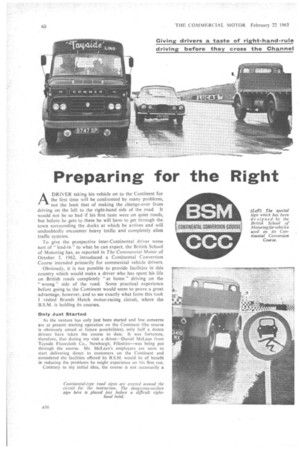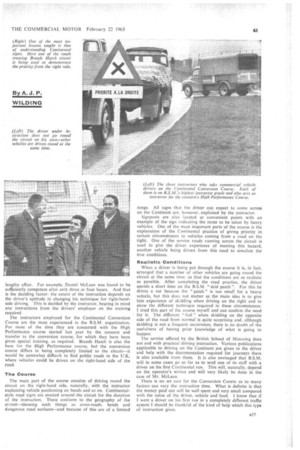Preparing for the Right
Page 62

Page 63

If you've noticed an error in this article please click here to report it so we can fix it.
ADRIVER taking his vehicle on to the Continent for the first time will be confronted by many problems, not the least that of making the change-over from driving on the left to the right-hand side of the road. It would not be so bad if his first taste were on quiet roads, but before he gets to these he will have to get through the town surrounding the docks at which he arrives and will undoubtedly encounter heavy traffic and completely alien traffic systems.
To give the prospective inter-Continental driver some sort of " lead-in " to what he can expect, the British School of Motoring has, as reported in The Commercial Motor of October 5. 1962, introduced a Continental Conversion Course intended primarily for commercial vehicle drivers.
Obviously, it is not possible to provide facilities in this country which would make a driver who has spent his life on British roads completely "at home" driving on the " wrong " side of the road. Some practical experience before going to the Continent would seem to prove a great advantage, however, and to see exactly what form this took I visited Brands Hatch motor-racing circuit, where the B.S.M. is holding its courses.
Only Just Started
As the venture has only just been started and few concerns are at present starting operation on the Continent (the course is obviously aimed at future possibilities), only half a dozen drivers have taken the course to date. It was fortunate, therefore, that during my visit a driver—Daniel McLean from Tayside Floorcloth Co., Newburgh, Fifeshire—was being put through the course. Mr. McLean's employers are soon to start delivering direct to customers on the Continent and considered the facilities offered by B.S.M. would be of benefit in reducing the problems he might experience on his first run.
Contrary to my initial idea, the course is not necessarily a
lengthy affair. For example. Daniel McLean was found to be sufficiently competent after only three or four hours. And that is the deciding factor: the extent of the instruction depends on the driver's aptitude in changing his technique for right-handside driving. This is decided by the instructor, bearing in mind any instructions from the drivers' employer on the training required The instructors employed for the Continental Conversion Course are the most experienced in the B.S.M. organization. For most of the time they are concerned with the High Performance course started last year by the concern and transfer to the conversion course, for which they have been given special training, as required. Brands Hatch is also the base for the High Performance course, but the conversion course differs in being completely limited to the circuit—it would be somewhat difficult to find public roads in the U.K. where vehicles could be driven on the right-hand side of the road.
The Course The main part of the course consists of driving round the circuit on the right-hand side, naturally, with the instructor explaining vehicle positioning on bends and so on. Continentalstyle road signs are erected around the circuit for the duration of the instruction. These conform to the geography of the circuit—showing such things as cross-roads, bends and dangerous road surfaces—and because of this are of a limited
range. All signs that the driver can expect to come across on the Continent are. however, explained by the instructor.
Signposts are also located at convenient points with an example of the sign indicating the route to be taken by heavy vehicles. One of the most important parts of the course is the explanation of the Continental practice of giving priority in certain circumstances to vehicles coming from a road on the right. One of the service roads running across the circuit is used to give the driver experience of Meeting this hazard, another vehicle being driven from this road to simulate the true conditions.
Realistic Conditions When a driver is being put through the course it is, in fact. arranged that a number of other vehicles are going round the circuit at the same time, so that the conditions are as reAlistic as possible. After completing the road practice, the driver spends a short time on the B.S.M. "skid patch ". For this he drives a car because the "patch" is too small for a heavy vehicle, but this does not matter as the main idea is to give him experience of skidding when driving on the right and to show the different technique required in these circumstances. I tried this part of the course myself and can confirm the need for it. The different " feel " when skidding on the opposite side of the road from normal is quite surprising and although skidding is not a frequent occurrence, there is no doubt of the usefulness of having prior knowledge of what is going to happen.
The service offered by the British School of Motoring does not end with practical driving Instruction. Various publications applicable to driving on the Continent are given to the driver and help with the documentation required for journeys there is also available from them. It is also envisaged that B.S.M. will in some cases go so far as to send one of its staff with a driver on his first Continental run. This will, naturally, depend on the operator's wishes and will very likely be done in the case of Mr. McLean.
There is no set cost for the Conversion Course as so many factors can vary the instruction time. What is definite is that the money paid out will be well spent and very small compared with the value of the driver, vehicle and load. I know that if were a driver on his first run in a completely different traffic system I should be thankful of the kind of help which this type of instruction gives.












































































































